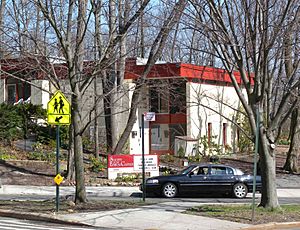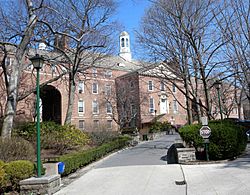Fieldston, Bronx facts for kids
Quick facts for kids
Fieldston
|
|
|---|---|
|
Neighborhood of the Bronx
|
|

Society for Ethical Culture
|
|
| Country | United States |
| State | New York |
| City | New York City |
| Borough | The Bronx |
| Community District | Bronx 8 |
| Area | |
| • Total | 0.426 sq mi (1.10 km2) |
| Population
(2011)
|
|
| • Total | 3,292 |
| • Density | 7,728/sq mi (2,984/km2) |
| Economics | |
| • Median income | $91,862 |
| ZIP Codes |
10471
|
| Area code | 718, 347, 929, and 917 |
Fieldston is a special neighborhood in the Riverdale area of the Bronx in New York City. It's known for being a very nice place to live, with lots of trees and big houses. It's also unique because it's one of the few neighborhoods in New York City that is completely privately owned.
Fieldston is bordered by Manhattan College Parkway to the south, Henry Hudson Parkway to the west, 250th Street to the north, and Broadway to the east. Many of its beautiful homes are part of the Fieldston Historic District. This means they are protected because of their important history and design.
This neighborhood is home to two famous schools: the Horace Mann School and the Ethical Culture Fieldston School. Manhattan College is also located right next to Fieldston.
Contents
How Did Fieldston Begin?
The Delafield Family's Vision
The land where Fieldston now stands was once part of a large estate. In 1829, a man named Major Joseph Delafield bought about 250 acres (100 hectares) of land. He named it after his family's estate in Ireland.
In 1909, the Delafield family decided to turn this land into a neighborhood. They called it "Delafield Woods" at first. Instead of using a simple grid pattern for streets, they chose a different approach.
Designing a Unique Neighborhood
A civil engineer named Albert E. Wheeler designed the streets. He followed ideas from famous landscape designers, making the streets curve with the land. This helped save many of the beautiful trees and wooded areas.
The first house in Fieldston was started in 1910 and finished in 1911. By 1923, about 80 houses were built. That's when the Fieldston Property Owners' Association was created. This group helps manage the neighborhood.
Building Beautiful Homes
When people bought land in Fieldston, they were given a list of approved architects. The goal was to build homes in classic "revival" styles, which looked back to older designs. The Tudor revival style was very popular in the 1920s.
Many houses were designed by local architects like Dwight James Baum and Julius Gregory. Their designs were so good that some houses were featured in design magazines. In 1938, a special rule was made to ensure only single-family homes could be built, keeping the neighborhood's unique feel.
Who Owns Fieldston's Streets?
A Private Community
Fieldston is special because it's one of the few neighborhoods in New York City that is completely privately owned. This means the streets and common areas don't belong to the city. Instead, they are owned by the Fieldston Property Owners' Association, Inc.
What the Association Does
The Property Owners' Association does many things that a city usually does. They plow the streets when it snows, fix sewers, and take care of the neighborhood's many trees (there are about 1000!). They also run a security patrol to keep the area safe.
Homeowners in Fieldston pay yearly fees to the Association for these services. To make sure the streets legally remain private, they are closed to non-residents once a year. Parking is also only for residents and their guests.
Famous Buildings in Fieldston
Fieldston's Historic District
In 2006, most of Fieldston was named an historic district by the New York City Landmarks Preservation Commission. This means its 252 houses and other buildings are protected. Many of these homes are examples of amazing architecture.
Here are a few notable houses and their styles:
- 274 College Road (1926–28): Designed by Julius Gregory in a Medieval Revival style.
- 4521 Delafield Road (1925): Designed by Dwight James Baum in a Colonial Revival style. It even won an award for being one of the best two-story houses built between 1926 and 1930 in the U.S.
- 5020 Goodridge Avenue (1914–15): This Tudor Revival home was once the residence of Mayor Fiorello La Guardia from 1945 to 1947. Later, author Robert Silverberg lived there.
- 4538 Greystone Avenue (c.1924): This house is known for its "turreted tower" and unique roof, making it one of the most charming in the neighborhood.
- 4401–4403 Waldo Avenue (1913): This building was originally an office for the Delafield Estate. It's now a private home.
Important Buildings Nearby
Even outside the historic district, Fieldston has important buildings:
- Hadley House (5122 Post Road): The middle part of this house is one of the oldest homes in the Bronx!
- Christ Church (5030 Henry Hudson Parkway East): A beautiful Victorian Gothic Revival church built in 1865–66.
- Riverdale Presbyterian Church (4763 Henry Hudson Parkway): Another historic church, built in 1863–64.
- Horace Mann School (231 West 246th Street): A well-known school with several modern buildings.
- Ethical Culture Fieldston School (3901 Fieldston Drive): Another top school in the area.
- Manhattan College (4513 Manhattan College Parkway): A Roman Catholic liberal arts college.



